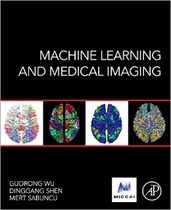
Key Features
therapy, landmark detection, imaging genomics, and brain connectomics
Description
Machine Learning and Medical Imaging presents state-of- the-art machine learning methods in medical image analysis.
It first summarizes cutting-edge machine learning algorithms in medical imaging, including not only classical
probabilistic modeling and learning methods, but also recent breakthroughs in deep learning, sparse
representation/coding, and big data hashing.
In the second part leading research groups around the world present a wide spectrum of machine learning methods with
application to different medical imaging modalities, clinical domains, and organs.
The biomedical imaging modalities include ultrasound, magnetic resonance imaging (MRI), computed tomography (CT),
histology, and microscopy images.
The targeted organs span the lung, liver, brain, and prostate, while there is also a treatment of examining genetic
associations.
Machine Learning and Medical Imaging is an ideal reference for medical imaging researchers, industry scientists and
engineers, advanced undergraduate and graduate students, and clinicians. 
Editor Biographies
Preface
Acknowledgments
Part 1: Cutting-Edge Machine Learning Techniques in Medical Imaging
Chapter 1: Functional connectivity parcellation of the human brainAbstract
1.1 Introduction
1.2 Approaches to Connectivity-Based Brain Parcellation
1.3 Mixture Model
1.4 Markov Random Field Model
1.5 Summary
Chapter 2: Kernel machine regression in neuroimaging geneticsAbstract
Acknowledgments
2.1 Introduction
2.2 Mathematical Foundations
2.3 Applications
2.4 Conclusion and Future Directions
Appendix A Reproducing Kernel Hilbert Spaces
Appendix B Restricted Maximum Likelihood Estimation
Chapter 3: Deep learning of brain images and its application to multiple sclerosisAbstract
Acknowledgments
3.1 Introduction
3.2 Overview of Deep Learning in Neuroimaging
3.3 Focus on Deep Learning in Multiple Sclerosis
3.4 Future Research Needs
Chapter 4: Machine learning and its application in microscopic image analysisAbstract
4.1 Introduction
4.2 Detection
4.3 Segmentation
4.4 Summary
Chapter 5: Sparse models for imaging geneticsAbstract
5.1 Introduction
5.2 Basic Sparse Models
5.3 Structured Sparse Models
5.4 Optimization Methods
5.5 Screening
5.6 Conclusions
Chapter 6: Dictionary learning for medical image denoising, reconstruction, and segmentationAbstract
6.1 Introduction
6.2 Sparse Coding and Dictionary Learning
6.3 Patch-Based Dictionary Sparse Coding
6.4 Application of Dictionary Learning in Medical Imaging
6.5 Future Directions
6.6 Conclusion
Glossary
Chapter 7: Advanced sparsity techniques in magnetic resonance imagingAbstract
7.1 Introduction
7.2 Standard Sparsity in CS-MRI
7.3 Group Sparsity in Multicontrast MRI
7.4 Tree Sparsity in Accelerated MRI
7.5 Forest Sparsity in Multichannel CS-MRI
7.6 Conclusion
Chapter 8: Hashing-based large-scale medical image retrieval for computer-aided diagnosisAbstract
8.1 Introduction
8.2 Related Work
8.3 Supervised Hashing for Large-Scale Retrieval
8.4 Results
8.5 Discussion and Future Work
Part 2: Successful Applications in Medical Imaging
Chapter 9: Multitemplate-based multiview learning for Alzheimer’s disease diagnosisAbstract
9.1 Background
9.2 Multiview Feature Representation With MR Imaging
9.3 Multiview Learning Methods for AD Diagnosis
9.4 Experiments
9.5 Summary
Chapter 10: Machine learning as a means toward precision diagnostics and prognosticsAbstract
10.1 Introduction
10.2 Dimensionality Reduction
10.3 Model Interpretation: From Classification to Statistical Significance Maps
10.4 Heterogeneity
10.5 Applications
10.6 Conclusion
Chapter 11: Learning and predicting respiratory motion from 4D CT lung imagesAbstract
Acknowledgment
11.1 Introduction
11.2 3D/4D CT Lung Image Processing
11.3 Extracting and Estimating Motion Patterns From 4D CT
11.4 An Example for Image-Guided Intervention
11.5 Concluding Remarks
Chapter 12: Learning pathological deviations from a normal pattern of myocardial motion: Added value for CRT studies
Abstract
Acknowledgments
12.1 Introduction
12.2 Features Extraction: Statistical Distance from Normal Motion
12.3 Manifold Learning: Characterizing Pathological Deviations from Normality
12.4 Back to the Clinical Application: Understanding CRT-Induced Changes
12.5 Discussion/Future Work
Chapter 13: From point to surface: Hierarchical parsing of human anatomy in medical images using machine learning
technologiesAbstract
13.1 Introduction
13.2 Literature Review
13.3 Anatomy Landmark Detection
13.4 Detection of Anatomical Boxes
13.5 Coarse Organ Segmentation
13.6 Precise Organ Segmentation
13.7 Conclusion
Chapter 14: Machine learning in brain imaging genomicsAbstract
14.1 Introduction
14.2 Mining Imaging Genomic Associations Via Regression or Correlation Analysis
14.3 Mining Higher Level Imaging Genomic Associations Via Set-Based Analysis
14.4 Discussion
Chapter 15: Holistic atlases of functional networks and interactions (HAFNI)Abstract
Acknowledgments
15.1 Introduction
15.2 HAFNI for Functional Brain Network Identification
15.3 HAFNI Applications
15.4 HAFNI-Based New Methods
15.5 Future Directions of HAFNI Applications
Chapter 16: Neuronal network architecture and temporal lobe epilepsy: A connectome-based and machine learning
studyAbstract
16.1 Introduction
16.2 Treatment Outcome Prediction of Patients With TLE
16.3 Naming Impairment Performance of Patients With TLE
Index


